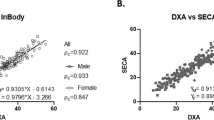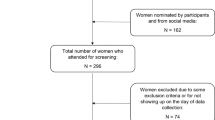Abstract
Objective: To describe body composition in patients with short bowel syndrome (SBS) by using bioelectric impedance spectroscopy (BIS), dual-energy X-ray absorptiometry (DXA) measurements and anthropometrical-derived estimates.
Subjects: In all, 19 patients were included, mean age 54 y, range 36–77 (F/M=11/8). Mean BMI was 21.5 kg/m2. Eight patients were on home parenteral nutrition (HPN).
Methods: Total body water (TBW), intracellular water and extracellular water were assessed by BIS. TBW were derived from DXA. Fat-free mass (FFM) was assessed by BIS and DXA. TBW and FFM were predicted according to an empirical formula. Differences were analysed using the Bland–Altman method.
Results: The mean difference between TBW (DXA) and TBW (BIS) was −1.1 l in women and −1.8 l in men. For FFM, the mean difference between FFM (DXA) and FFM (BIS) was −1.7 kg in women and −2.5 kg in men. The mean difference between TBW (DXA) and TBW (BIS) for all patients was –1.2 l and limits of agreement were (–7.80−5.40). Hydration of FFM assessed by BIS gave a mean of 0.75 (0.08).
Conclusion: The limits of agreement (Bland–Altman) between DXA and BIS were wide, indicating that methods are not interchangeable, which limits its clinical utility. Most of our patients with SBS were maintained in a stable clinical condition within normal limits of body weight and BMI. FFM and TBW did not appear to be altered in ileostomates or those on HPN.
Sponsorship: The study was supported by grants from the Swedish Medical research Council (17X-03117), Göteborgs Läkarsällskap and IB and A Lundbergs forskningsstiftelse.
This is a preview of subscription content, access via your institution
Access options
Subscribe to this journal
Receive 12 print issues and online access
$259.00 per year
only $21.58 per issue
Buy this article
- Purchase on Springer Link
- Instant access to full article PDF
Prices may be subject to local taxes which are calculated during checkout

Similar content being viewed by others
References
Bland JM & Altman DG (1986): Statistical methods for assessing agreement between two methods of clinical measurement. Lancet 1, 307–310.
Bruce A, Andersson M, Arvidsson B & Isaksson B (1980): Body composition. Prediction of normal body potassium, body water and body fat in adults on the basis of body height, body weight and age. Scand. J. Clin. Lab. Invest. 40, 461–473.
Carlsson E, Bosaeus I & Nordgren S (2002): Body composition in patients with an ileostomy and inflammatory bowel disease: validation of bio-electric impedance spectroscopy (BIS). Eur. J. Clin. Nutr. 56, 680–686.
Chambrier C, Normand S, Ecochard R, Pachiaudi C, Laville M & Bouletreau P (2001): Total-body-water measurement with 18O-labeled water in short-bowel patients with an ileostomy. Nutrition 17, 287–291.
Christie PM, Knight GS & Hill GL (1990): Metabolism of body water and electrolytes after surgery for ulcerative colitis: conventional ileostomy versus J pouch. Br. J. Surg. 77, 149–151.
Chumlea C & Guo S (1997): Bioelectric impedance: a history, research issues, and recent consensus. In Emerging Technologies for Nutrition Research, eds. S Carlson-Newberry & R Costello, pp 169–192. Washington, DC: National Academy Press.
Cox-Reijven PL & Soeters PB (2000): Validation of bio-impedance spectroscopy: effects of degree of obesity and ways of calculating volumes from measured resistance values. Int. J. Obes. Relat. Metab. Disord. 24, 271–280.
De Lorenzo A, Andreoli A, Matthie J & Withers P (1997): Predicting body cell mass with bioimpedance by using theoretical methods: a technological review. J. Appl. Physiol. 82, 1542–1558.
Deurenberg P, Tagliabue A & Schouten FJ (1995): Multi-frequency impedance for the prediction of extracellular water and total body water. Br. J. Nutr. 73, 349–358.
Deurenberg P, Weststrate J, Paymans I & van der Kooy K (1998): Factors affecting bioelectrical impedance measurements in humans. Eur. J. Clin. Nutr. 42, 1017–1022.
Egger NG, Carlson GL & Shaffer JL (1999): Nutritional status and assessment of patients on home parenteral nutrition: anthropometry, bioelectrical impedance, or clinical judgment? Nutrition 15, 1–6.
Ellis KJ, Shypailo RJ & Wong WW (1999): Measurement of body water by multifrequency bioelectrical impedance spectroscopy in a multiethnic pediatric population. Am. J. Clin. Nutr. 70, 847–853.
Geerling BJ, Lichtenbelt WD, Stockbrugger RW & Brummer RJ (1999): Gender specific alterations of body composition in patients with inflammatory bowel disease compared with controls. Eur. J. Clin. Nutr. 53, 479–485.
Going SB, Massett MP, Hall MC, Bare LA, Root PA, Williams DP & Lohman TG (1993): Detection of small changes in body composition by dual-energy x-ray absorptiometry. Am. J. Clin. Nutr. 57, 845–850.
Gudivaka R, Schoeller DA, Kushner RF & Bolt MJ (1999): Single- and multifrequency models for bioelectrical impedance analysis of body water compartments. J. Appl. Physiol. 87, 1087–1096.
Haderslev K & Staun M (2000): Comparison of dual-energy X-ray absorptiometry to four other methods to determine body composition in underweight patients with chronic gastrointestinal disease. Metabolism 49, 360–366.
Heymsfield SB, Wang Z, Visser M, Gallagher D & Pierson Jr RN (1996): Techniques used in the measurement of body composition: an overview with emphasis on bioelectrical impedance analysis. Am. J. Clin. Nutr. 64, 478S–484S.
Kyle UG, Morabia A, Slosman DO, Mensi N, Unger P & Pichard C (2001): Contribution of body composition to nutritional assessment at hospital admission in 995 patients: a controlled population study. Br. J. Nutr. 86, 725–731.
Lehnert M, Clarke D, Gibbons J, Ward L, Golding S, Shepherd R, Cornish B & Crawford D (2001): Estimation of body water compartments in cirrhosis by multiple-frequency bioelectrical-impedance analysis. Nutrition 17, 31–34.
Pace N & Rathbun E (1945): Studies on body composition. III The body water and chemically combined nitrogen content in relation to fat content. J. Biol. Chem. 158, 685–691.
Royall D, Greenberg GR, Allard JP, Baker JP, Harrison JE & Jeejeebhoy KN (1994): Critical assessment of body-composition measurements in malnourished subjects with Crohn's disease: the role of bioelectric impedance analysis. Am. J. Clin. Nutr. 59, 325–330.
Schoeller DA (1992): Isotope dilution methods. In Obesity, eds. B Björntorp & B Brodoff, pp 80–88. New York: Lippingcott.
Smith D, Engel B, Diskin A, Spanel P & Davies S (2002): Comparative measurements of total body water in healthy volunteers by online breath deuterium measurement and other near-subject methods. Am. J. Clin. Nutr. 76, 1295–1301.
Spanel P & Smith D (2001): Accuracy and precision of flowing afterglow mass spectrometry for the determination of the deuterium abundance in the headspace of aqueous liquids and exhaled breath water. Rapid Commun. Mass Spectrom. 15, 867–872.
Tjellesen L, Nielsen PK & Staun M (1998): Body composition by dual-energy X-ray absorptiometry in patients with Crohn's disease. Scand. J. Gastroenterol. 33, 956–960.
Tjellesen L, Staun M & Nielsen PK (1997): Body composition changes measured by dual-energy X-ray absorptiometry in patients receiving home parenteral nutrition. Scand. J. Gastroenterol. 32, 686–690.
van den Ham E, Kooman J, Christiaans M, Nieman F, Van Kreel B, Heidendal G & Van Hooff J (1999): Body composition in renal transplant patients: bioimpedance analysis compared to isotope dilution, dual energy X-ray absorptiometry, and anthropometry. J. Am. Soc. Nephrol. 10, 1067–1079.
Van Loan MD & Mayclin PL (1992): Body composition assessment: dual-energy X-ray absorptiometry (DEXA) compared to reference methods. Eur. J. Clin. Nutr. 46, 125–130.
Van Marken Lichtenbelt WD, Westerterp KR, Wouters L & Luijendijk SC (1994): Validation of bioelectrical-impedance measurements as a method to estimate body-water compartments. Am. J. Clin. Nutr. 60, 159–166.
Wang Z, Deurenberg P, Wang W, Pietrobelli A, Baumgartner RN & Heymsfield SB (1999a): Hydration of fat-free body mass: new physiological modeling approach. Am. J. Physiol. 276, E995–E1003.
Wang Z, Deurenberg P, Wang W, Pietrobelli A, Baumgartner RN & Heymsfield SB (1999b): Hydration of fat-free body mass: review and critique of a classic body- composition constant. Am. J. Clin. Nutr. 69, 833–841.
Ward L, Doman D & Jebb S (2000): Evaluation of a new bioelectrical impedance instrument for the prediction of body cell mass independently of height or weight. Nutrition 16, 745–750.
Acknowledgements
This investigation was supported by grants from the Swedish Medical Research Council (17X-03117), Göteborgs Läkarsällskap, and IB och A Lundbergs Forskningsstiftelse.
Author information
Authors and Affiliations
Corresponding author
Rights and permissions
About this article
Cite this article
Carlsson, E., Bosaeus, I. & Nordgren, S. Body composition in patients with short bowel syndrome: An assessment by bioelectric impedance spectroscopy (BIS) and dual–energy absorptiometry (DXA). Eur J Clin Nutr 58, 853–859 (2004). https://doi.org/10.1038/sj.ejcn.1601886
Received:
Revised:
Accepted:
Published:
Issue Date:
DOI: https://doi.org/10.1038/sj.ejcn.1601886
Keywords
This article is cited by
-
Increased Adiposity and Reduced Lean Body Mass in Patients with Short Bowel Syndrome
Digestive Diseases and Sciences (2020)
-
Bioelectric impedance spectroscopy underestimates fat-free mass compared to dual energy X-ray absorptiometry in incurable cancer patients
European Journal of Clinical Nutrition (2009)



